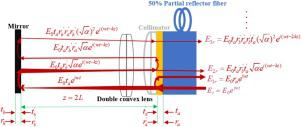Sensors and Actuators A: Physical ( IF 4.1 ) Pub Date : 2020-11-26 , DOI: 10.1016/j.sna.2020.112394 Hervé Nguendon Kenhagho , Ferda Canbaz , Raphael Guzman , Philippe Cattin , Azhar Zam

|
We report on a custom-made, fiber-coupled Fabry-Pérot etalon sensor to measure the acoustic shock waves (ASW) generated during laser ablation. A frequency-doubled Nd:YAG laser (532 nm) with a 5 ns pulse duration was used to produce craters on the surfaces of five different tissues —hard and soft bone, muscle, fat and skin— from five fresh porcine proximal and distal femur specimens. After collecting the ASW signals generated during laser ablation, we split the Fourier spectrum of the measured ASW into six equal bands and used each as an input for principal component analysis (PCA). We used PCA to reduce the dimensionality of each band and fed the PCA scores to an Artificial Neural Network (ANN) for classification. The most accurate tissue differentiation occurred at a band of 1.67–2.08 MHz. In total 18000 data points were collected from the femur samples and split into training (10800), validation (3600, and testing (3600) data. From a confusion matrix and the receiver operating characteristic (ROC), we observed that the experimental-based scores of hard and soft bone, fat, muscle and skin yielded average classification accuracies (with leave-one-out cross-validation) of 100 %, 99.55 %, 88.89%, 99.33%, and 100%, respectively. The area under the ROC curve (AUC) was more than 98.61 %, for all tissue types. The proposed method has the potential to provide real-time feedback during laser osteotomy, to prevent the cutting of vital tissues.
中文翻译:

用于智能激光骨凿的小型光声反馈传感器:光纤耦合法布里-佩罗标准具传感器
我们报告了一种定制的,纤维耦合的Fabry-Pérot标准具标准传感器,用于测量激光烧蚀过程中产生的声波(ASW)。脉冲持续时间为5 ns的Nd:YAG倍频激光(532 nm)被用于在五个不同的猪股骨近端和远端的五个不同组织(硬和软的骨骼,肌肉,脂肪和皮肤)的表面上产生弹坑标本。收集激光烧蚀过程中产生的ASW信号后,我们将测得的ASW的傅立叶光谱分成六个相等的带,并分别用作主成分分析(PCA)的输入。我们使用PCA来减少每个频段的维数,并将PCA分数输入到人工神经网络(ANN)进行分类。最准确的组织分化发生在1.67–2.08 MHz的频带上。我们观察到,基于实验的硬,软骨,脂肪,肌肉和皮肤得分产生了100%,99.55%,88.89%,99.33%和100%的平均分类准确度(留一法交叉验证) , 分别。对于所有组织类型,ROC曲线下面积(AUC)均大于98.61%。所提出的方法具有在激光截骨术期间提供实时反馈的潜力,以防止重要组织的切割。我们观察到,基于实验的硬性和软性骨骼,脂肪,肌肉和皮肤得分产生100%,99.55%,88.89%,99.33%和100%的平均分类准确度(留一法交叉验证) , 分别。对于所有组织类型,ROC曲线下面积(AUC)均大于98.61%。所提出的方法具有在激光截骨术期间提供实时反馈的潜力,以防止重要组织的切割。











































 京公网安备 11010802027423号
京公网安备 11010802027423号